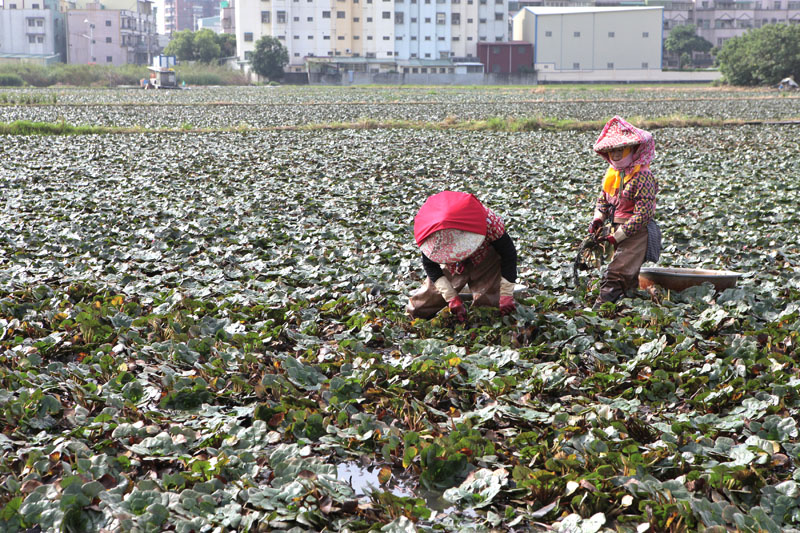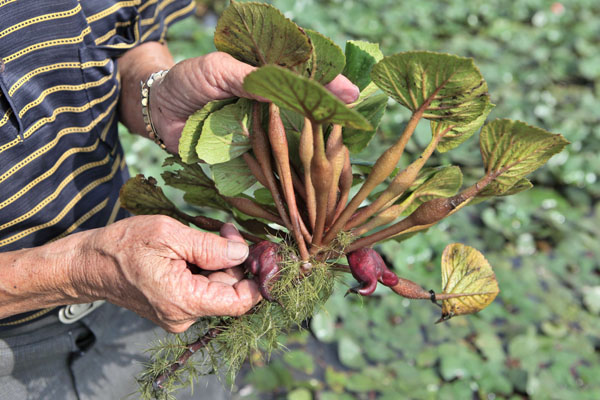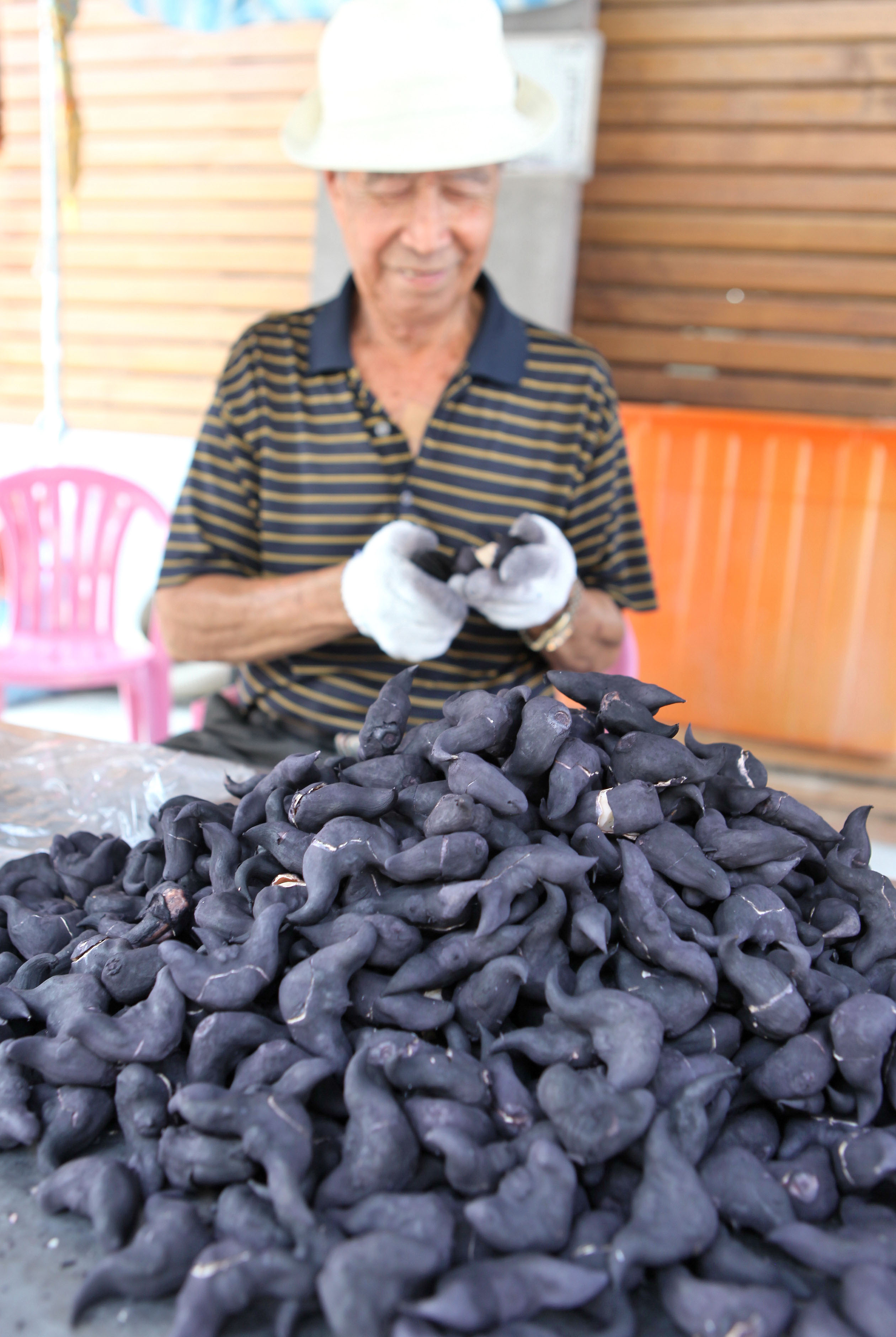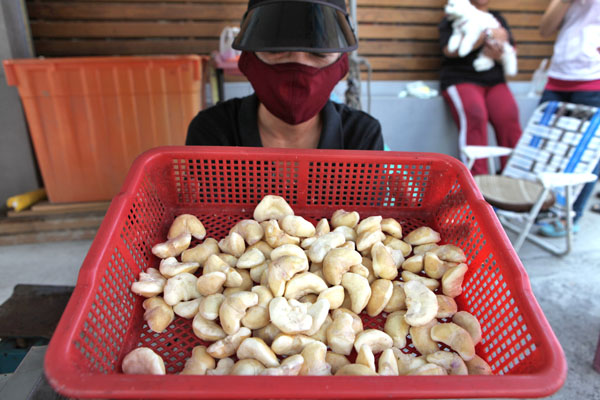The Life Story of a Trapa Guardian: Mr. Tseng Chun-fong/菱角飄香一甲子 曾春風的菱角人生
The Life Story of a Trapa Guardian: Mr. Tseng Chun-fong
◎English translation: Peng Hsin-yi
◎Photos by Yang Wei-ren
 Kaohsiung's Zuoying District is now a place where high-rises tower against the skyline. Few know or even remember, that back in the days Zuoying was dotted with ponds where trapas (also known as water caltrops or water chestnuts) were cultivated. Mr. Tseng Chun-fong, fondly known by many as "Uncle Trapa," is one of those who has witnessed the transformation of Zuoying from a trapa farmer's point of view.
Kaohsiung's Zuoying District is now a place where high-rises tower against the skyline. Few know or even remember, that back in the days Zuoying was dotted with ponds where trapas (also known as water caltrops or water chestnuts) were cultivated. Mr. Tseng Chun-fong, fondly known by many as "Uncle Trapa," is one of those who has witnessed the transformation of Zuoying from a trapa farmer's point of view.
Mr. Tseng started working in a trapa farm when he was 17. He is 84 years old now, and is still on the job even after over 60 years of hard work. Every morning, rain or shine, Mr. Tseng rolls up his pants and makes his rounds in the trapa pond. He says: "I am a local kid, born and raised here right by the Yuandi Temple. We were poor, so I didn't get any education. But there were trapa farms everywhere near Lotus Pond, so I went to help and try to make some money. Before I knew it, 60 years have passed and here I am."
Mr. Tseng says five of his siblings went into trapa farming with him. In the 1960s, when trapa farming was at its peak, the family owned 40 to 50 akkars (a unit of land measurement originally introduced by the Dutch, who colonized south Taiwan in the 17th century). One akkar equals 0.96 hectares. During harvest time, Mr. Tseng and his siblings had to hire about 80 temporary workers to help.
 As Zuoying became modernized, Mr. Tseng moved to Kaohsiung's Renwu District and continued to live a farmer's life. Today, "Uncle Trapa" runs a farm that is only about two hectares in size, but his annual output of 20,000 jin (a unit of weight also known as a catty and equal to 600g; 20,000 jin is thus 12,000kg or over 11 tons) means he remains a leader in trapa production in Kaohsiung. With endless rolls of green leaves at his back, Mr. Tseng explains that trapa takes three to four months to mature; the harvest season is usually October or November. After harvesting, he grows rice in the field while starting a new batch of trapa sprouts in the nursery. By the time the rice is harvested, the new trapas are ready for transplanting.
As Zuoying became modernized, Mr. Tseng moved to Kaohsiung's Renwu District and continued to live a farmer's life. Today, "Uncle Trapa" runs a farm that is only about two hectares in size, but his annual output of 20,000 jin (a unit of weight also known as a catty and equal to 600g; 20,000 jin is thus 12,000kg or over 11 tons) means he remains a leader in trapa production in Kaohsiung. With endless rolls of green leaves at his back, Mr. Tseng explains that trapa takes three to four months to mature; the harvest season is usually October or November. After harvesting, he grows rice in the field while starting a new batch of trapa sprouts in the nursery. By the time the rice is harvested, the new trapas are ready for transplanting.
Mr. Tseng says there is no secret to good trapa. The only requirements are good water and proper soil composition. Both Zuoying and Renwu benefit from rich, soft soils which aid trapa's growth. That's why his trapas are sweet and have a springy texture. They are not only favored by locals, but are also popular among visitors from other places. Growing trapas is not as demanding as rice, yet it is hard work nevertheless. Mr. Tseng says he makes his rounds every day, applying fertilizer when necessary. His livelihood is highly dependent on the weather. If a typhoon or thunderstorm hits the area while the plants are flowering, the storm can strip the plants of their flowers and there will be no fruit. "You see?" he says, bending down and pulling a trapa plant out of the water. Flipping it over to show the back of the leaves, he adds: "That little white dot is the flower."
 If all goes well, the horned fruit grows right beneath the leaf. When mature, the fruit develops two prominent horns while the skin turns dark red. But those who have never tried it should not be intimidated by its appearance, as underneath that stubborn shell is creamy like fresh fruit; it is lovely anyway you eat it. Mr. Tseng recommends eating it raw just like a fruit. It does taste quite a bit like a fresh Asian pear: crispy and sweet. However, most people boil trapas and eat them like peanuts. The shell turns black after it is boiled, while the fruit becomes soft and starchy with a delicate fragrance to it. Shelled raw trapas are also an excellent cooking ingredient, often found in traditional dishes such as sticky rice pilaf, congee, or braised with pork ribs. Next time you visit Kaohsiung, buy a bag of trapas when you see them for sale, and enjoy!
If all goes well, the horned fruit grows right beneath the leaf. When mature, the fruit develops two prominent horns while the skin turns dark red. But those who have never tried it should not be intimidated by its appearance, as underneath that stubborn shell is creamy like fresh fruit; it is lovely anyway you eat it. Mr. Tseng recommends eating it raw just like a fruit. It does taste quite a bit like a fresh Asian pear: crispy and sweet. However, most people boil trapas and eat them like peanuts. The shell turns black after it is boiled, while the fruit becomes soft and starchy with a delicate fragrance to it. Shelled raw trapas are also an excellent cooking ingredient, often found in traditional dishes such as sticky rice pilaf, congee, or braised with pork ribs. Next time you visit Kaohsiung, buy a bag of trapas when you see them for sale, and enjoy!
| Where to buy? |
Tseng Chun-fong
Tel: (07)341-3810 |
菱角飄香一甲子 曾春風的菱角人生
◎文、攝影/楊為仁
 曾幾何時,左營地區廣漠的菱角田 ,已成為櫛比鱗次的高樓大廈,種植菱角逾60載的「菱角伯仔」曾春風繼續轉至仁武種植菱角,平實地過著日出而作、日落而息的農耕生活。
曾幾何時,左營地區廣漠的菱角田 ,已成為櫛比鱗次的高樓大廈,種植菱角逾60載的「菱角伯仔」曾春風繼續轉至仁武種植菱角,平實地過著日出而作、日落而息的農耕生活。
從17歲開始種植菱角,84歲的曾春風身子依舊硬朗,一輩子與菱角為伍的他,每天一大清早,就捲著褲管到菱角田巡視:「我是左營元帝廟旁的在地囝仔,從小家境清寒、又沒念什麼書,看到有人在蓮池潭種菱角,跟著幫忙採收,做久了也做出一番心得來。」曾春風說,家裡有5個兄弟姐妹全投入種植菱角的工作。到了民國50幾年,菱角全盛時期,曾春風的菱角栽植面積4、50甲,採收時必須雇用80多人。
如今,菱角伯的菱角田剩下仁武區八卦寮的2公頃,但年產量2萬多斤,在高雄市仍首屈一指,面對一望無際的翠綠菱角田,曾春風說,菱角從種植到採收約需3、4個月的時間,一般而言,每年10月到11底是菱角的產季,收成後,會改種稻米,並另外找地方栽培菱角苗,待稻米收成,菱角苗也培育差不多,即可接著種植。
曾春風表示,菱角要好吃,水質和土壤都很重要。左營和八卦寮的菱角田土質均屬於軟土,土質的Q度夠,所以種植的菱角甘甜又香Q,不但在地人愛吃 ,也吸引外地人前來購買。
種植菱角,雖然不像種稻那麼麻煩,但還是很辛苦,每天要到菱角田施肥、巡視,曾春風表示,菱角跟大多數農作物一樣,要靠天吃飯,如果開花期碰到颱風或大雷雨,花被打落就結不出果實來了,說到菱角花,曾春風彎下腰,從水裡拉起一株菱盤,翻開菱葉後露出一個小白點,「你看,白色的就是菱角花。」
 菱角長在菱盤的下方,有兩個尖角,菱角殼呈紅褐色,剝開後就可看到白皙的果肉,至於該怎麼吃?曾春風笑笑說:「我都是直接把生菱角剝開吃。」生菱角的口感有點像水梨,又脆又甜,不過,大多數的人還是會把菱角煮熟後吃,如果直接當零嘴吃,就會將採收洗淨的菱角,放進大鍋裡煮,煮熟的菱角殼顏色會變黑,果實更香更軟;但如果是買回家做菱角料理,則會把生菱角剝殼販售,成為製作米糕、菱角粥或菱角排骨的絕佳食材,下回有機會到高雄,別忘了買袋菱角回家細細品嚐。
菱角長在菱盤的下方,有兩個尖角,菱角殼呈紅褐色,剝開後就可看到白皙的果肉,至於該怎麼吃?曾春風笑笑說:「我都是直接把生菱角剝開吃。」生菱角的口感有點像水梨,又脆又甜,不過,大多數的人還是會把菱角煮熟後吃,如果直接當零嘴吃,就會將採收洗淨的菱角,放進大鍋裡煮,煮熟的菱角殼顏色會變黑,果實更香更軟;但如果是買回家做菱角料理,則會把生菱角剝殼販售,成為製作米糕、菱角粥或菱角排骨的絕佳食材,下回有機會到高雄,別忘了買袋菱角回家細細品嚐。
| 哪裏買? |
曾春風的菱角
電話:07-3413810 |